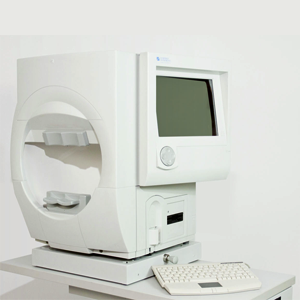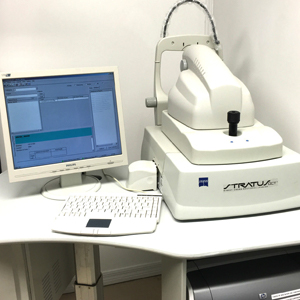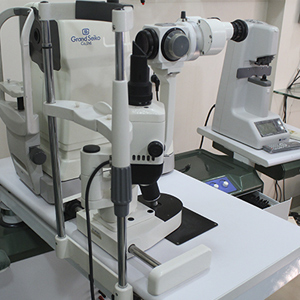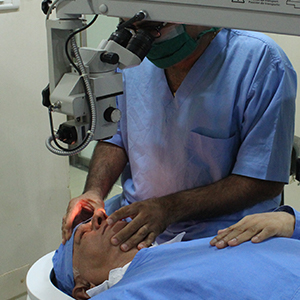
At Khandwala Eye Hospital You will be cared by an excellent Ophthalmologists for both your preoperative and postoperative visits. Here, Laser Vision Correction includes a pre-procedure visit and a thorough examination, the procedure itself, and all follow-up care to ensure the best possible results.
Understanding Glaucoma
Don't let the sun set on your sight..
Glaucoma is a disease that damages the optic nerve. The optic nerve carries electrical impulses of the light images transformed by the retina, to our brain. Damage to the optic nerve and retina causes blind spots in the field of vision. In extreme cases, if the entire nerve is destroyed, blindness will occur.
Glaucoma is in fact one of the leading causes of blindness and affects an estimated one of every 50 adults.
Although glaucoma can occur at any age, the risk of developing this increases dramatically after the age of 35.
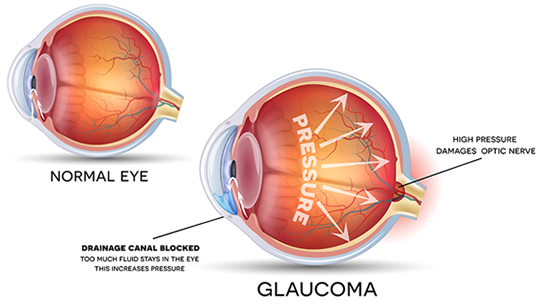
High Pressure on Optic Nerves
At Khandwala's Eyecare, We will check your IOP and evaluate your optic nerve. If your eye pressure is elevated or your optic nerve looks suspicious, We will likely perform visual field tests and specialized
scans of your retina and optic nerve to determine if you have glaucoma.

Symptoms of Glaucoma..
At first, open-angle glaucoma has no symptoms. It causes no pain. Vision stays normal. Glaucoma can developin one or both eyes. Without treatment,people with glaucoma will slowly lose their peripheral (side) vision. As glaucoma remains untreated, people may miss objects to the side and out of the corner of their eye. They seem to be looking through a tunnel. Over time, straight-ahead (central) vision may decrease until no vision remains.
A Walkthough Video of Glaucoma..
Glaucoma Risk Increases in Families: Spread the Word..
Glaucoma is a worldwide problem that can lead to blindness. It is especially problematic because there are often no symptoms in its early stages. It is estimated that up to 50 percent of people with glaucoma don't realize they have it.Numerous population-based studies have demonstrated that one of the greatest risk factors for glaucoma is a family history of the disease. That means that one of the most important things you can do is to talk about glaucoma with your family and encourage them to take steps to preserve their vision.People at high risk for glaucoma should get a complete eye exam, including eye dilation, every one or two years.Glaucoma is much more common among older people. You are six times more likely to get glaucoma if you are over 60 years old.
Types of Glaucoma..
The two major categories of glaucoma are Open-angle glaucoma (OAG) and Narrow angle glaucoma (NOG).
The "angle" in both cases refers to the drainage angle inside the eye that controls the outflow of the watery fluid (aqueous) that is continually being produced inside the eye.If the aqueous can access the drainage angle,the glaucoma is known as open angle glaucoma. If the drainage angle is blocked and the aqueous cannot reach it, the
glaucoma is known as narrow angle glaucoma.
Variations of OAG include: primary open angle glaucoma (POAG), normal-tension glaucoma (NTG), pigmentary glaucoma, pseudoexfoliation glaucoma, secondary glaucoma
and congenital glaucoma.Variations of narrow angle glaucoma include include acute angle closure glaucoma, chronic angle closure glaucoma, and neovascular glaucoma.
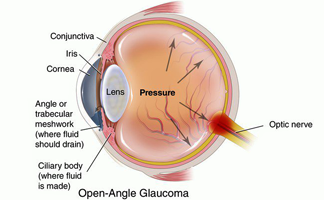
- The most common form of glaucoma, accounting for
at least 90% of all glaucoma cases: - Is caused by the slow clogging of the drainage canals, resulting in increased eye pressure.
- Has a wide and open angle between the iris and cornea.
- Develops slowly and is a lifelong condition.
- Has symptoms and damage that are not noticed.
- Family history of glaucoma.
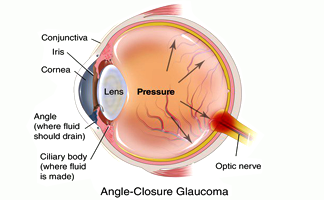
- Angle-closure glaucoma, a less common form of glaucoma:
- Is caused by blocked drainage canals, resulting in a sudden rise in intraocular pressure.
- Has a closed or narrow angle between the iris and cornea.
- Has symptoms and damage that are usually very noticeable.
- Demands immediate medical attention.
- Develops very quickly.
More Categories :
Are there other types of Glaucoma ?
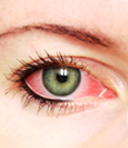
Yes.
Although there is only two major types of Glaucoma : Open Angle and Narrow Angle : futher below are the some more categories related to both.
Primary open-angle glaucoma.
Acute angle-closure glaucoma.
Normal-tension glaucoma.
Pigmentary glaucoma.
Secondary glaucoma.
Congenital glaucoma.
How is Glaucoma Detected ?
Glaucoma is detected through a comprehensive dilated eye exam that includes the following:
Visual acuity test : An Eye chart test measures how well you see at various distances.
Visual field test: This test measures your peripheral (side vision). It helps your eye care professional
tell if you have lost peripheral vision, a sign of glaucoma.
Dilated eye exam : In this exam, drops are placed in your eyes to widen, or dilate, the pupils. Your eye
care professional uses a special magnifying lens to examine your retina and optic nerve for signs of
damage and other eye problems. After the exam, your close-up vision may remain blurred
for several hours.
Tonometry : Tonometry is the measurement of pressure inside the eye by using an instrument called a tonometer. Numbing drops may be
applied to your eye for this test. A tonometer measures pressure inside the eye to detect glaucoma.
Oct : Screening with Ocular Coherence Tomography (OCT) enables diagnoses of potentially serious conditions that can affect your eyesight.
An advanced eye scan, OCT, uses light to illustrate the different layers that make up the back of your eye. In OCT scan, a digital photograph
and a three dimensional cross sectional scan of the back of the eye are obtained. At Khandwala Eyecare the OCT scan is used extensively in
detecting if you are at risk of glaucoma or the stage of glaucoma you are at. OCT is also used to detect, identify and monitor the progress of
age-related macular degeneration and macular hole. It also enables the early detection and treatment of diabetic retinopathy and
vitreomacular traction.
Pachymetry : is the measurement of the thickness of your cornea. Your eye care professional applies a numbing drop to your eye and uses an ultrasonic wave instrument to measure the thickness of your cornea.
Glaucoma Treatments..

